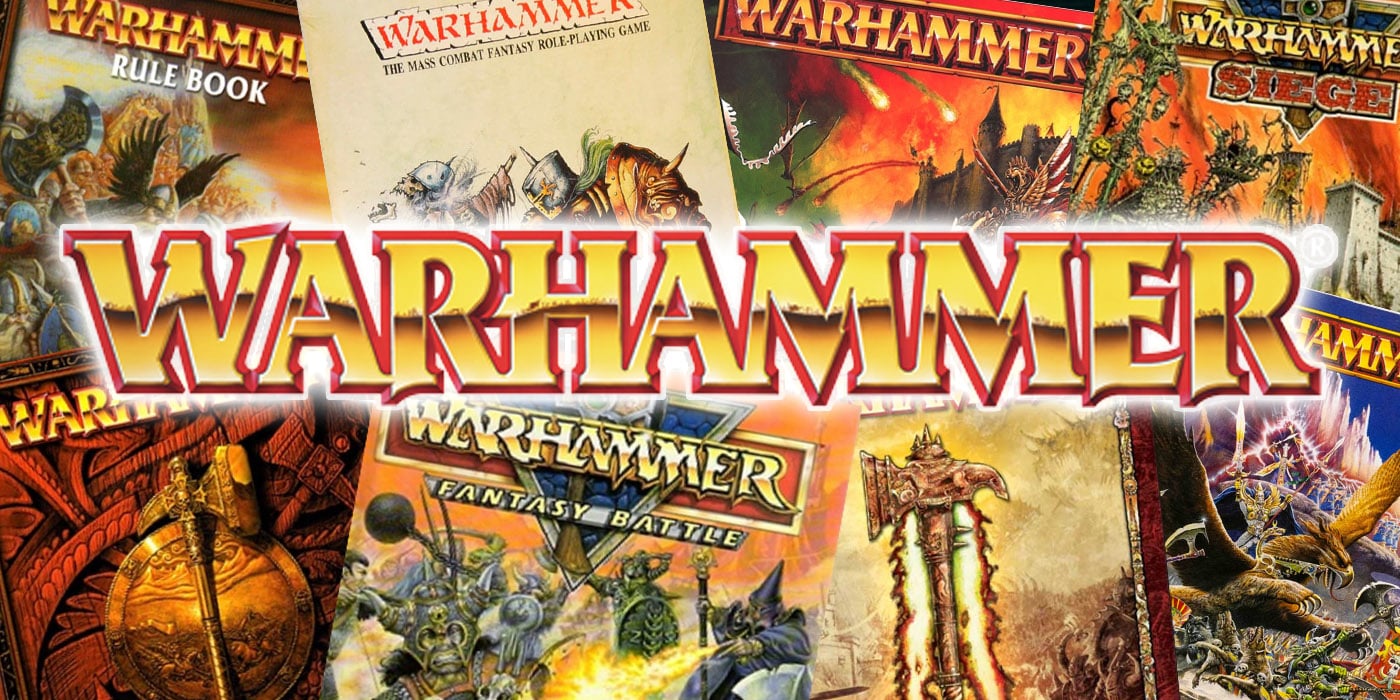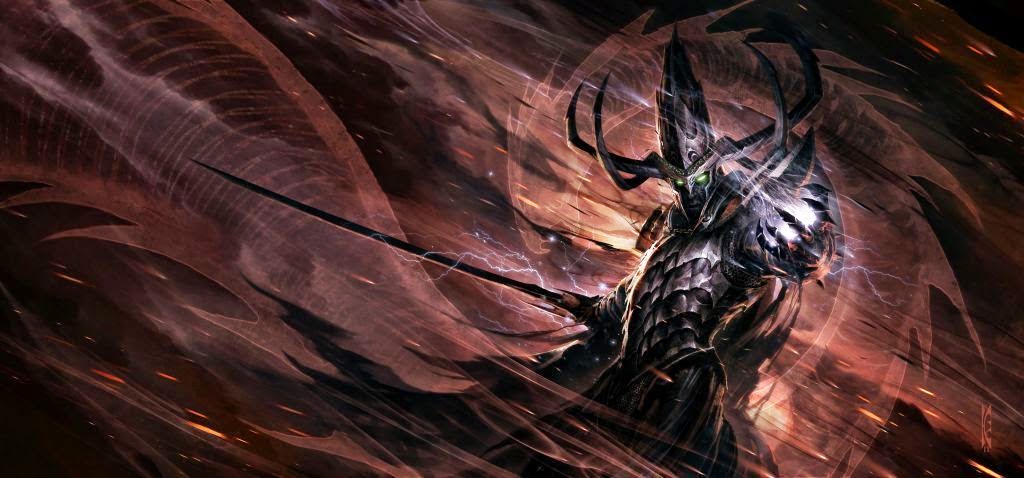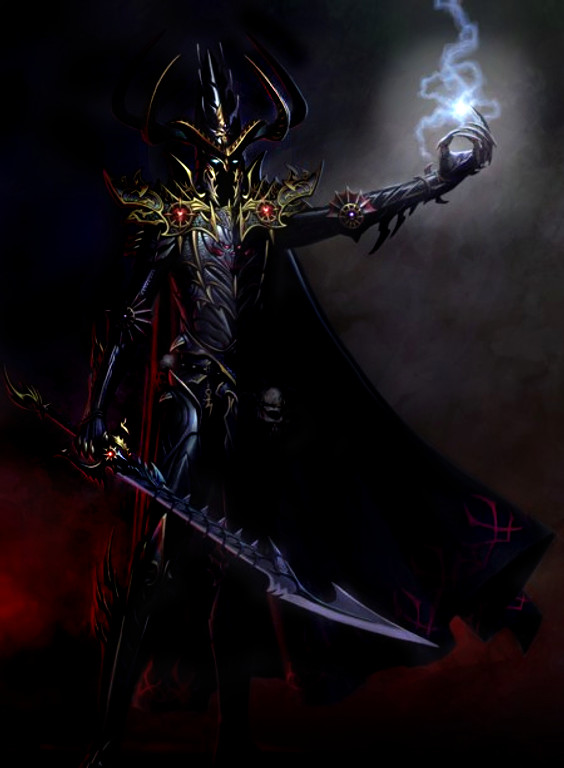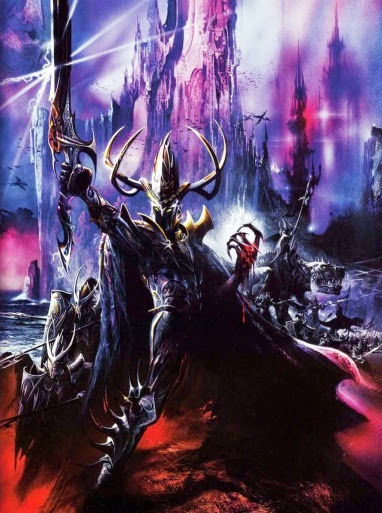End Times: Khaine – Malekith

Move over Nagash – today we take a detailed look at Malekith as presented in End Times: Khaine!
There are many tyrants and ne’er do-wells in the world of Warhammer Fantasy, but none with quite as “illustrious” a career of villainy as the Witch King of Naggaroth – Malekith, scorned son of Aenarion and rightful ruler of Ulthuan. It would no doubt have come as a shock to all that Malekith was not the true villain of the Elf-oriented End Times book but instead perhaps their only real hope of survival and unity; truly ironic, seeing as it was Malekith that originally split the Elf race apart thousands of years prior. While the king of all Elves has come to lead them once more through the dark ages of war and strife, the arrogant, cruel Witch King still resides within – even if Malekith functionally is nothing like his prior Dark Elf incarnation!
End Times Characters and Units
Malekith, the Phoenix King
As I mentioned to many fellow wargamers both abroad and at my local store, the combined monster-and-rider profiles released so far were no doubt impressive, but there was no doubt in my mind the Elf ones would be by far the most ridiculous of the bunch. As we can see with the two Malekith profiles and the reintroduced Imrik, my prediction has proven correct – even if I wouldn’t necessarily say these units are over-powered, as is the case with Malekith as the Phoenix King. While the profile and rules are all roughly as you would expect of Malekith sharing a combined profile with the Black Dragon Seraphon, there are some very important differences between the army book incarnation and both of the new End Times: Khaine variants. For one, Malekith has replaced the Destroyer with Asuryath, a trade that I am sure many feel would favour the former considering its natural synergy with the unchanged Armour of Midnight. Still, Asuryath is nonetheless a very nasty melee weapon as it ignores Regeneration saves due to having the Flaming Attacks special rule, while it also multiples each unsaved wound inflicted into D3 unsaved wounds.
When you factor in that Malekith always re-rolls to hit due to Eternal Hatred, will likely fight before opponents due to Always Strikes First and Initiative 8, all the while having a jaw-dropping 10 Attacks, it isn’t difficult to see Malekith absolutely destroying entire units at a time – don’t forget about the juicy Strength 6 Thunderstomp! The problem with Asuryath – and this is exemplified when Malekith fights Tyrion as the Avatar of Khaine – is that there are too many insanely cheap and easy ways to virtually ignore Flaming Attacks via a 2+ ward save, including the Fireborn special rule native to High Elves as well as the cheap Dragonbane Gem and Dragonhelm. Still, it goes without saying that Malekith as the Phoenix King is essentially a hard counter to Throgg and his Troll horde, able to destroy the entire unit with pitiless ease by himself. Because of the number of attacks and Thunderstomp, Malekith is a superior combatant than Tyrion against units and especially those that are Flammable or rely on Regeneration saves, though obviously he falls short of the Avatar of Khaine when fighting against other characters.
As far as the profile is concerned, Malekith is surpassed only by Imrik as far as raw stats are concerned; he is Weapon Skill 8, Initiative 8 and Strength 6, marking out a truly impressive fighter. On the flip side, he is Toughness 6 with 9 all-important Wounds, as well as a 3+ total armour save typical of a Black Dragon. That he has 10 Attacks is essentially the icing on the cake, though he also makes for a great leader with a 24″ Inspiring Presence and Leadership 10 similar to Karl Franz Ascendant. His mount Seraphon helps out in combat with a Strength 4 Breath Weapon that inflicts a -1 penalty to both Weapon Skill and Ballistic Skill on any unit struck by it, while he also packs in a wealth of supporting special rules such as Immune to Psychology and Terror. That he is a Flying monster means he can quickly and easily get into the enemy backfield and start causing havoc, with your average 6×4 gaming board signalling a turn two charge at the latest if you really want Malekith in combat early on.
Where it all starts to get a little bit ridiculous is that Malekith has a 2+ ward save against any non-magical attacks due to his Armour of Midnight, ensuring that only Dwarven war machines, Wood Elf Enchanted Arrows and Magic Missiles or Direct Damage spells have any chance of doing significant damage to him. Even if your opponent somehow gets lucky with any of these, Malekith is immune to any effect that causes more than one wound as long as it draws from either the Heroic Killing Blow or Multiple Wounds special rules, meaning that even runic war machines are no safe bet against the newly crowned Phoenix King. That he is all but untouchable against non-magical attacks means that various armies and even strong competitive builds are left completely worthless against Malekith; he is able to take on and easily hold up an Irongut “death-star” without even breaking a sweat, regardless of whether he charges the front or the flanks! As if that wasn’t enough, Malekith is a Level 4 Wizard that knows all of the spells (per the End Times Magic rules) from the Lore of Fire and Lore of Dark Magic, giving him a very impressive 16 spells to choose from including the End Times spells and Signature spells.
He can neuter enemy melee prowess and mobility while launching a devastating barrage of damage-dealing spells at anything that has even the slightest chance of threatening him, making full use of the fact that he is a Monster with the Fly special rule. The last noteworthy aspect of Malekith’s rules is his Circlet of Iron, a hugely important Arcane Item when one considers how one must now randomly determine the number of dice available to cast any given spell. Being able to add a single bonus dice to any failed casting or dispel attempts is crazily good on a Level 4 Wizard and especially so in the new rules, making Malekith one of the more reliable spell-casters in Warhammer Fantasy right now. To make matters even worse for opponents, Malekith provides an extra boost to all friendly Elven units with the Martial Prowess special rule – basically any actual Elf, but not any of the multiple beasts or monsters – by allowing them to fight (but not shoot) in yet another rank more than usual. What this means is that any Elf unit within 12″ of Malekith will normally fight in a crazy four ranks, increasing to five if they have spears or are in horde formation, and six if those latter two are combined.
While some might argue that Tyrion’s buff is better in certain cases, one can’t deny that striking in two extra ranks than normal gives the Host of the Phoenix King a huge overall advantage when fighting the Aestyrion. As for the points cost, when you consider that Malekith even in his Phoenix King variation can still easily beat Nagash or Karl Franz Ascendant in combat while being a super-powered wizard with almost incomparable defences makes for one supremely valuable model; any Host of the Phoenix King list should include either him or Teclis as either are almost mandatory competitively. He is the perfect general, a great wizard, a combat destroyer, a nightmare to kill and a hugely mobile monster all rolled into one terrifying package. Heck, he costs just as much as Malekith riding Seraphon from the regular Dark Elf army book does, and he actually uses the combined profile and has a few other rather significant buffs as well! While his Eternity King profile is more powerful overall and can’t be so easily countered by cheap magic items that provide a 2+ ward save against Flaming Attacks, Malekith as the Phoenix King still provides users with a valid reason to use the Host of the Phoenix King in both scenario-based and standard games where he will prove to be a true terror on the battlefield. The fact that he denies re-rolls to hit against opponents that also feature Always Strikes First but doesn’t lose his own re-rolls due to Eternal Hatred – much like his Black Guard cohorts – is a chilling reminder of why none can suffer the Witch…err, Phoenix King’s wrath!
Competitive? Yes!
Malekith, the Eternity King
Seeing as many of the traits and aspects possessed by Malekith as the Eternity King are shared by his lesser Phoenix King incarnation, I’ll stop short of the futility of repeating myself about all the reasons why Malekith featuring a combined profile with Seraphon is absolutely bonkers. The stats are virtually identical across the two versions of Malekith; the only exception here is that Malekith as the Eternity King has one extra wound, providing the game with yet another extremely rare 10 Wound model. This profile is second only to Imrik for the title of “best stat-line in the game” with absolutely no obvious exploitable weaknesses, much like Nagash or Karl Franz Ascendant and completely unlike the Glottkin which is just a few hundred points shorter but packs in a self-defeating Initiative 1. If wargamers thought that Nagash and Karl Franz Ascendant had broken the game in regards to almost unstoppable special characters dominating standard-sized games due to the End Times character allowance, Malekith as the Eternity King should surely be occupying their every nightmare by now.
An immunity to Heroic Killing Blow and Multiple Wounds means Malekith is magnitudes more survivable than any of the other super-powered characters introduced in the three End Times books so far, while 10 Wounds at Toughness 6, a 3+ armour save and a 2+ ward save against all non-magical attacks means even taking one wound off of Malekith is no easy feat. That the vast majority of attacks in the game are effectively laughed off by a 1000 point character that can fly, cast spells and tear units apart solo is just abhorrent and won’t help to calm those players opposed to these new demi-god level characters. Basically, everything that made the Phoenix King variation good is even more apparent here with that extra wound, though once you throw in the various significant changes offered by the Eternity King you will see why he easily sits beside or even above Nagash for the crown of most powerful single model in Warhammer Fantasy.
First off, Malekith the Eternity King benefits from Murderous Prowess instead of just Martial Prowess, much like all Elves in the Host of the Eternity King list. Re-rolling 1s to wound in close combat is a darned awesome buff for such an expensive combat character packing in 10 Strength 6 Attacks, but the real value comes from how he provides benefits to friendly Elves within 12. Like the Phoenix King, this version of Malekith allows Elves within 12″ to fight in yet another rank more than normal even when accounting for bonuses such as horde formation, spears or Martial Prowess itself; what really sets the Eternity King apart is that he also possesses Tyrion’s buff, allowing those same Elves to re-roll all failed to wound rolls when fighting in close combat. Basically, he’s a flying Cauldron of Blood that provides even more buffs – such as a 24″ Inspiring Presence with Leadership 10 – to non-ranged units (a reason for the Cauldron to feature in “gun-lines”) and turns all of your combat units and even dedicated ranged units into the most effective point-for-point fighters in the game.
The fact that this buff affects himself is even crazier given that he also always re-rolls failed to hit rolls due to Eternal Hatred; that Malekith will almost always strike before his enemy or enemies and re-rolls all failed to hit and to wound rolls makes him the most efficient close combat character in the game. This also means Malekith is pretty much the very best General option in the game what with his Leadership 10 and insanely good support abilities, while the change to Asuryath also ensures Malekith will (assuming average rolls) defeat any other combat character in the game one-on-one, including Karl Franz Ascendant, the Glottkin, Nagash, Orghotts Daemonspew and so on. The removal of Flaming Attacks from Asuryath means Malekith as the Eternity King is worse against Flammable units or those that can make use of Regeneration, though these units are definitely more the exception than the norm and the fact that Malekith can’t be held up by a 2+ ward save against Flaming Attacks due to a cheap magic item is worth the trade-off I feel. It is nice that the reforged Asuryath has the Multiple Wounds (D3+1) special rule, making it ever so slightly better than the regular version against models with more than one wound – this is a big part of what allows Malekith to engage and defeat other heavyweights such as Karl Franz Ascendant in hand-to-hand combat.
A cool bonus here is that Malekith is now also a Level 5 Wizard that is a Loremaster of the Lore of Shadow, meaning that he does lose out on eight spells compared to Phoenix King Malekith but can instead re-roll all casting attempts when using his favoured lore. It certainly helps that the Lore of Shadow is one of the most powerful spell lores in Warhammer Fantasy (at least pre-End Times anyway) and is hilarious in the new rules with the ability to impose all of the debilitating Hex spells on multiple units at a time. Oh, and don’t forget that so long as you don’t fail the casting attempt – which Malekith can re-roll, by the way – he can cast Pit of Shades as many times as he wants in any single Magic Phase provided he has the dice to do so – don’t forget the Circlet of Iron that provides a single bonus dice to any of his failed casting or dispel attempts! Heck, Malekith even comes stock with the in-built ability to re-roll results on the miscast chart, ensuring that the two nastiest results (“sucked into the warp” and losing wizard levels) will almost never happen. Short of Nagash and a select few such as Teclis or a Slaan with the Wandering Deliberations discipline, Malekith ranks as among the best wizards in the game as a result of all these various rules and he is equipped with one of the best spell lores available to boot.
If you haven’t already had enough of this insane Malekith profile, he can freely provide allow either himself or a single friendly unit within 12″ to make a 20″ move as if they were an Ethereal unit during the Remaining Moves sub-phase as opposed to moving normally. While you will rarely need to do this with Malekith himself as he already marches 20″, being able to get one of your units into a position they need to be with absolutely no possible way for the opponent to interfere is just insane in a game that is literally all about positioning. Here are some fancy but ultimately preliminary ideas for you; push a Witch Elf horde unit right into the opponent’s face on turn one backed by two marching Frostheart Phoenixes and Malekith himself, daring them to charge you or be charged; take a horde of Darkshards and place them behind the enemy battle-lines out of harms way and free to fire indiscriminately; give terrain-laden boards or choke-points the bird by providing a Dragon Prince or Cold One Knight bus with the Banner of the World Dragon Ethereal movement, and; put a War Hydra on the flank of a large but fragile infantry unit and use its breath weapon to maximum effect.
The ways in which you can make full use of this special rule are quite possibly limitless and give you unprecedented control of the battlefield; never mind that Malekith is the best combat character in the game, one of its’ best wizards and definitely the most survivable single model around, all for the same points cost as Nagash. In a competitive environment, that 1000 point price-tag is not enough to outweigh just how insanely powerful Malekith is and how he just gives your army essentially everything it could ever need short of a Battle Standard Bearer and Dispel Scroll all in one under-priced character. I could write for hours about just how insane Malekith the Eternity King is but unfortunately it would involve lots of ranting and doughnuts and I’m just not prepared to go down that route and I doubt you as an audience are either, so instead I’ll just leave this review on one final note; Malekith is the most powerful single model in Warhammer Fantasy. There, I said it. You can all argue whether Nagash is the more powerful of the two “millenial” characters, but ultimately as a single model there is just no comparison – Nagash relies on you being able to summon an army to really justify his cost, whereas Malekith will be a terrifying presence (and an almost immortal one at that) on the battlefield regardless of the circumstances.
Competitive? Yes.
Thank you for reading this early look at the new combined profiles for Malekith, first as the Phoenix King and then as the Eternity King. The former Witch King of Naggaroth is easily one of the most powerful special characters in the game not just due to his excessive abilities weighted against his cost, but also because he is strong in almost every single phase of the game barring the Shooting phase. Even so, he is such a fantastic general, combat monster and tough cookie as it is that dealing with him will prove exceptionally difficult outside of spammable magic missiles that can reliably ignore his armour saves. Thanks again and have a lovely day!




